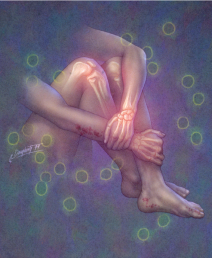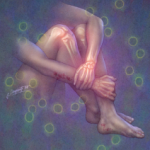
Type 1 lupus covers classic signs that can be measured with the SLE Disease Activity Index. Type 2 symptoms are unclear in origin and have an uncertain connection to inflammation.
A new disease model for lupus tackles issues with fatigue and other serious conditions that, although quite common among patients, get less attention because they fall outside classic symptoms associated with inflammation, a debilitating force behind systemic lupus erythematosus (SLE).
The model features subtypes to categorize two main groups of symptoms into type 1, typically related to inflammation and treated with immunosuppressants, and type 2, which covers common complaints of fatigue, insomnia and depression. The model was developed collaboratively by lupus researchers and clinicians at Duke University Medical Center, Durham, N.C., and outlined in a 2019 review article in Arthritis Care & Research.
“When patients come in and say, ‘I’m tired,’ sometimes the thought is that the tiredness is due to something else,” says David Pisetsky, MD, PhD, a professor of medicine and immunology at Duke and a translational researcher who helped develop the model. “In our model, fatigue is very much a part of lupus, and physicians and other providers should address this symptom as part of their management of the lupus.”
A chronic autoimmune disease that attacks the body’s own tissue and organs, lupus is highly heterogeneous and involves various signs and symptoms. The possibility of organ failure related to local and systemic inflammation is a key concern and often the focus of treatment with immune-suppressing medications.
Type 1: Classic Signs
Type 1 covers classic signs of lupus that can be measured with the SLE Disease Activity Index. They include nephritis, arthritis and vasculitis, and involve symptoms of pain localized to sites of inflammation, such as joints that become swollen and tender.
Type 1 symptoms are easily validated with lab tests, whereas type 2 symptoms are not, says Dr. Pisetsky. Thus, a gulf between inflammation-related symptoms and otherwise serious symptoms exists and has an impact on how doctors communicate with, and treat, patients, he says.
Type 2: Fatigue, Depression, Insomnia

Dr. Pisetsky
Type 2 symptoms are assessed less well by conventional measures of disease activity, are unclear in origin and have an uncertain connection to inflammation. Even though a large majority of lupus patients experience fatigue and many also have chronic pain, cognition difficulty and bouts of depression and insomnia, these symptoms are not part of the established measurements of lupus.
“All of these symptoms cause significant problems for patients with lupus and a great deal of distress,” says Dr. Pisetsky. “Yet, in the conventional measures of disease activity, they are not well represented.”
In the view of these researchers, lupus is not confounded by such conditions as fatigue or fibromyalgia, they are part of it, according to Dr. Pisetsky. Thus, they created a scheme that includes them as a fundamental aspect of the disease.
“In a sense, we are repositioning where we place these symptoms in the scheme of disease, but I think the importance is to recognize that they are really part of lupus,” he says.
The disease model proposed by the Duke team includes symptoms “in a more unified way,” incorporating as essential features of lupus those conditions that are typically considered comorbidities. It helps get around the problem when a patient says “my lupus is active” but lab results don’t show it, says Dr. Pisetsky.
The collaboration of lupus researchers and clinicians at Duke came about by listening to patients speak about their problems and acknowledging that very often their symptoms were not considered disease activity even though they posed major problems for the patient.
“That led us to this idea that these symptoms, what we now call type 2, are very much part of lupus,” says Dr. Pisetsky. “They’re not just incidental. They’re not coincidental. They are part of lupus, but they do not easily fit into the usual scheme—looking at disease activity or looking at damage.
“What we did is to try to come up with a model that incorporates both types, signs and symptoms in a common framework to evaluate patients.”
Type 1 & Type 2 Mix
It is not unusual for lupus patients to experience symptoms that fall into both categories or vary between the two types at different times of active disease, explains Dr. Pisetsky.
“The likelihood, and what our data suggest, is that patients have mixtures of symptoms; some have a significant number of type 1 problems but don’t have very many type 2. Other patients have many more type 2 issues, but don’t have a lot of type 1,” says Dr. Pisetsky.
A clinical evaluation can identify whether a patient is one type or the other, or has mixed activity from both types.
“For example, a patient with SLE may have low disease activity or even disease in remission in terms of type 1 manifestations and associated biomarkers; nevertheless, that patient may experience severe type 2 manifestations and be limited by unrelenting pain and fatigue,” states the article.

